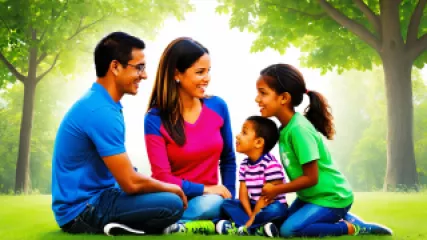Building Resilience in Children: One Parent's Journey
Building Resilience in Children: One Parent's Journey
As a parent, nothing is more important to me than the wellbeing and development of my children. It's a responsibility I take incredibly seriously, and one that has led me on a profound personal journey over the past several years. This is the story of how I learned to build resilience in my children, and the invaluable lessons I've gained along the way.
My name is Kent Carter, and I'm the proud father of two amazing kids, Travis and Annie. When they were younger, I'll admit that I was often overwhelmed by the challenges of parenthood. The tantrums, the meltdowns, the constant need for attention – it could be exhausting. But as I watched my children grow, I began to realize that these difficult moments were actually opportunities for them to develop crucial life skills.
The Awakening
It all started when Travis, my oldest, went through a particularly rough patch around age 8. He was struggling with anxiety at school, feeling overwhelmed by the social dynamics and academic pressures. As a parent, my first instinct was to swoop in and try to "fix" the problem – to shield him from the discomfort and make everything okay. But something told me that approach wasn't going to serve him in the long run.
So instead, I started doing research. I wanted to understand the nature of childhood resilience – what it was, why it mattered, and how I could help cultivate it in my own kids. What I learned was eye-opening. Resilience, it turns out, is not just about bouncing back from adversity, but about developing the inner strength and coping skills to navigate life's challenges with confidence and adaptability.
Armed with this new knowledge, I began to shift my parenting approach. Rather than trying to eliminate all of Travis's struggles, I started encouraging him to face them head-on. I helped him develop strategies for managing his anxiety, like deep breathing exercises and positive self-talk. I also made sure to validate his feelings, letting him know that it was okay to feel scared or overwhelmed sometimes.
Fostering Resilience
As Travis began to make progress, I realized that building resilience wasn't just about helping him through a specific challenge. It was about instilling a mindset and a set of skills that would serve him well throughout his life. So I started applying the same principles to my parenting of Annie, who was a few years younger.
One of the key things I learned was the importance of allowing my children to experience and work through their own difficulties, rather than swooping in to rescue them. It was tempting, of course, to want to spare them from pain or discomfort. But I knew that by doing so, I'd be depriving them of the opportunity to develop the very skills they'd need to thrive.
So instead, I started encouraging Travis and Annie to problem-solve on their own, offering guidance and support only when they truly needed it. When they faced conflicts with friends or struggled with a challenging assignment at school, I would ask them questions like, "What do you think you could do to handle this?" or "What has worked for you in the past when you've felt this way?"
I also made a conscious effort to model resilient behavior myself. When I faced my own setbacks or difficulties, I would talk to my kids about how I was coping, and the strategies I was using to move forward. I wanted them to see that resilience wasn't just something they needed to cultivate, but something that was important for all of us.
The Power of Mindset
As my children continued to grow and develop, I realized that a key component of resilience-building was mindset. The way we think about challenges and adversity, I learned, can have a profound impact on how we respond to them.
So I started working with Travis and Annie to help them cultivate a growth mindset – the belief that their abilities and skills are not fixed, but can be developed through effort and persistence. I encouraged them to see challenges not as threats, but as opportunities for learning and growth.
"Resilience is not something you're born with – it's a skill that can be learned and strengthened over time. And as a parent, I believe it's one of the most important gifts we can give our children."Kent Carter
This mindset shift was transformative. Instead of getting discouraged or giving up when they faced difficulties, my kids started to approach them with a sense of curiosity and determination. They became more willing to take risks, try new things, and bounce back from setbacks.
Of course, it wasn't always easy. There were still plenty of tears, tantrums, and frustrations along the way. But I could see the resilience muscle growing stronger with each challenge they faced and overcame.
Therapeutic Support and Workshops
As my children's resilience continued to develop, I also realized the value of seeking out additional support and resources. I enrolled them in a series of resilience-building workshops, where they learned techniques for managing stress, regulating their emotions, and building healthy relationships.
These workshops were incredibly impactful, not only for my kids but for me as a parent as well. I learned so much about the science behind childhood resilience, and the specific strategies that can be used to nurture it. Things like mindfulness, cognitive-behavioral therapy, and even adventure-based activities were all part of the curriculum.
But perhaps the most valuable aspect of these workshops was the sense of community and belonging that they fostered. Travis and Annie were able to connect with other kids who were navigating similar challenges, and they learned that they weren't alone in their struggles. This sense of camaraderie and shared experience was incredibly empowering.
In addition to the workshops, we also sought out the support of a family therapist. This was a decision that wasn't always easy, as I initially worried about the stigma associated with seeking mental health support. But the insights and guidance we gained from our sessions were truly transformative.
Through our work with the therapist, we were able to unpack some of the deeper emotional and behavioral patterns that were impacting our family dynamic. We learned new communication techniques, conflict resolution strategies, and ways to support one another through difficult times.
Most importantly, the therapist helped us to see that resilience-building isn't just about the individual – it's about the whole family system. By working together to cultivate a nurturing, supportive environment, we were able to create a foundation for our children's growth and development that was stronger than ever before.
The Rewards of Resilience
As I reflect back on this journey, I'm filled with a deep sense of gratitude and pride. Watching my children grow into resilient, compassionate, and self-assured individuals has been one of the greatest joys of my life.
Travis, who once struggled with crippling anxiety, is now a confident and curious young person who embraces challenges with an open mind. He's developed a toolkit of strategies for managing his emotions and maintaining his mental health, and he's not afraid to ask for help when he needs it.
Annie, too, has blossomed into a resilient and adaptable individual. She's learned to navigate the ups and downs of adolescence with a remarkable sense of inner strength and self-awareness. She's developed a strong support system of friends and mentors, and she's not afraid to take risks and step outside her comfort zone.
But the real reward, for me, has been the deeper connection and understanding that has emerged within our family. By working together to build resilience, we've cultivated a sense of trust, empathy, and mutual respect that I know will carry us through whatever challenges may come our way.
I know that the journey of resilience-building is an ongoing one, with no end in sight. There will always be new hurdles to overcome, new skills to develop, and new ways to grow. But I'm confident that with the foundation we've built, my children are well-equipped to face those challenges head-on.
And as for me, I'll continue to be there every step of the way, offering guidance, support, and a listening ear. Because at the end of the day, that's what parenting is all about – not just helping our children survive, but helping them thrive.
Conclusion
Resilience is not something that children are born with – it's a skill that can be cultivated and strengthened over time. As a parent, I've learned that by creating an environment of support, fostering a growth mindset, and providing opportunities for children to develop coping strategies, we can empower them to navigate life's challenges with confidence and adaptability.
The journey of building resilience in my own children has been a profound and rewarding one, filled with both challenges and triumphs. But the lessons I've learned along the way – about the importance of allowing our kids to face their fears, the power of mindset, and the value of seeking out therapeutic support – are ones that I believe can benefit all parents and families.
So if you're a parent who's struggling with the ups and downs of raising resilient children, take heart. With time, patience, and a commitment to nurturing their inner strength, you too can help your kids develop the skills they need to thrive, no matter what life throws their way.






